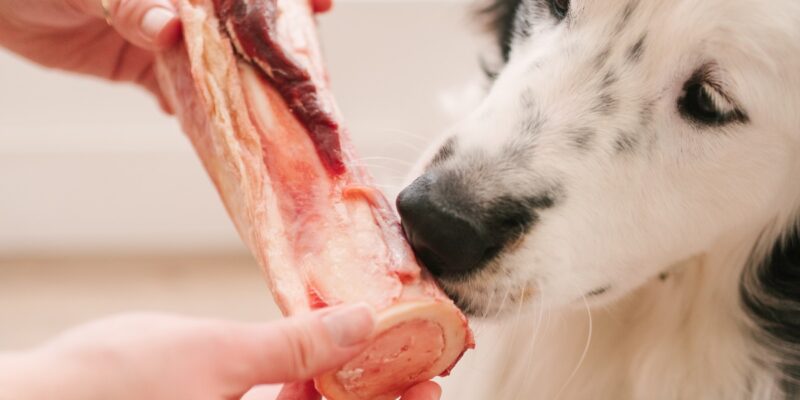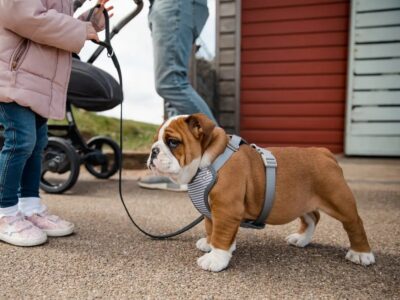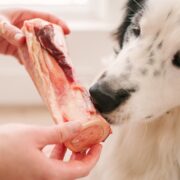The Definitive Guide to Dog Bones: Finding the Perfect Chew for Your Canine Companion
Why Dogs Love Chewin’ on Bones
Dogs have an inherent need to chew, and providing them with bones can satisfy that instinctual urge. Chewing on bones is a natural behavior for dogs, as it allows them to exercise their jaws, strengthen their teeth, and keep themselves occupied. When dogs gnaw on bones, it releases endorphins, giving them a sense of pleasure and satisfaction. This is why dogs love to chew on bones and will often spend hours doing so.
- The Instinctual Need to Chew
The instinctual need to chew comes from dogs’ ancestors, who used their teeth and jaws for hunting and survival. Chewing helps dogs keep their teeth clean and healthy, as it removes plaque and tartar buildup. Additionally, chewing on bones can relieve teething discomfort in puppies and provide mental stimulation for adult dogs.
- Dental Health Benefits
Regular chewing on bones can help maintain good oral hygiene for dogs. As dogs gnaw on bones, the mechanical action of chewing scrapes away plaque and tartar from their teeth, reducing the risk of dental diseases such as gum inflammation and tooth decay. It also promotes healthy gums and can prevent bad breath. However, it’s essential to choose appropriate bones to avoid dental damage, as some bones can be too hard and may cause tooth fractures or other dental issues.
- Stress Relief and Mental Stimulation
Chewing on bones is not only enjoyable for dogs but also provides them with stress relief and mental stimulation. Dogs have a natural instinct to chew when they are anxious or bored, and providing them with bones can redirect this behavior. Chewing releases endorphins, which can help dogs relax and alleviate stress. It also keeps their minds engaged and prevents them from destructive chewing on household items. Bones can be an excellent way to keep your canine companion mentally stimulated and content.
Choosing the Right Bone for Your Pup
When it comes to choosing the right bone for your pup, there are several factors to consider. From size to material and your dog’s chewing style, finding the perfect fit is crucial for their safety and enjoyment.
- Size Matters: Finding the Perfect Fit
One of the most important factors to consider when selecting a bone for your dog is the size. The bone should be appropriate for your dog’s size to ensure they can chew on it comfortably and safely. A bone that is too small can be a choking hazard, while a bone that is too large may be too difficult for your dog to chew. It’s important to choose a bone that matches your dog’s size and chewing capabilities.
- Bone Material: Which One is Pawsome for Your Dog?
There are different materials available for dog bones, each with its own pros and cons. It’s essential to choose a bone material that is safe and suitable for your dog.
Raw Bones: Raw bones, such as beef or lamb bones, are a popular choice for many dog owners. They are natural, nutritious, and can provide hours of chewing pleasure for your dog. However, raw bones can splinter, which can be dangerous if swallowed. It’s important to monitor your dog while they are chewing on raw bones and remove any small, sharp pieces that may pose a choking hazard.
Dental Chew Bones: Dental chew bones are specifically designed to promote dental health. They are usually made of a hard material that helps scrape away plaque and tartar as your dog chews. Some dental chew bones also contain ingredients that freshen your dog’s breath and promote gum health. These bones are a great option for dogs who need extra dental care.
Synthetic Bones: If you’re concerned about the potential hazards of natural bones, synthetic bones are a safe and durable alternative. Made from materials like nylon or rubber, synthetic bones are long-lasting and come in various shapes and sizes. They are designed to withstand heavy chewing and are often infused with flavors that dogs love. Synthetic bones are a popular choice for aggressive chewers and can provide hours of entertainment.
- Consider Your Dog’s Chewing Style
Every dog has a different chewing style, and it’s essential to consider this when selecting a bone. Some dogs are gentle chewers and may prefer softer bones, while others are powerful chewers and require tougher bones. Understanding your dog’s chewing style will help you choose a bone that can withstand their chewing habits and provide them with an enjoyable chewing experience.
Exploring Different Types of Dog Bones
There are various types of dog bones available on the market, each with its unique characteristics and benefits. Let’s delve into the different types and explore their features.
- Raw Bones: Nature’s Ultimate Chew Toy
Raw bones are the closest you can get to nature’s ultimate chew toy for your dog. They are unprocessed and provide a range of flavors and textures that dogs find irresistible. Raw bones can keep your dog entertained for hours and provide essential nutrients, including calcium and phosphorus, for their overall health. However, as mentioned earlier, raw bones can splinter, so it’s crucial to supervise your dog while they are chewing and remove any small, sharp pieces that may pose a hazard.
- Dental Chew Bones: Combining Taste and Oral Health
Dental chew bones are designed to promote both taste and oral health. These bones typically have a textured surface that helps scrub away plaque and tartar as your dog chews. Some dental chew bones also contain ingredients like mint or parsley, which freshen your dog’s breath. These bones provide a fun and tasty way for your dog to maintain good oral hygiene.
- Synthetic Bones: A Safe and Long-Lasting Alternative
Synthetic bones offer a safe and long-lasting alternative to natural bones. Made from durable materials like nylon or rubber, synthetic bones are designed to withstand heavy chewing. They are often infused with flavors that dogs love, making them even more enticing. Synthetic bones are ideal for aggressive chewers and can provide hours of entertainment and satisfaction.
Caring for Your Dog’s Chew Bone
Proper care and maintenance are essential to ensure your dog’s chew bone remains safe and enjoyable. Here are some tips to help you take care of your dog’s chew bone:
- Cleaning and Maintenance Tips
Regularly clean your dog’s chew bone to prevent the buildup of bacteria and keep it hygienic. Depending on the type of bone, you can clean it by rinsing it under running water, using a mild soap, or even using a dog-safe disinfectant. Avoid using harsh chemicals or cleaners that may be harmful to your dog.
Inspect the bone for any signs of wear and tear and replace it if necessary. Over time, bones can become brittle or develop sharp edges, which can pose a risk to your dog’s health. Regularly check the bone for any damage to ensure it remains safe for your dog to chew on.
- Ensuring Safety During Chew Time
When giving your dog a chew bone, it’s important to create a safe environment for them to enjoy it. Supervise your dog while they are chewing to prevent any accidents or choking hazards. If you have multiple dogs, give them their own separate bones to avoid any potential conflicts or resource guarding.
Choose an appropriate area for your dog to chew, preferably on a non-slip surface. This will prevent the bone from slipping and your dog from accidentally injuring themselves while chewing.
- Knowing When to Replace the Bone
Even the toughest bones will eventually wear out over time. It’s essential to know when to replace your dog’s chew bone to prevent any possible hazards. If the bone becomes too small, develops sharp edges, or starts to crack or break, it’s time for a replacement. Inspect the bone regularly and replace it if it shows any signs of damage.
Additionally, some dogs may lose interest in a bone once they have chewed on it for a while. If your dog seems uninterested or no longer engages with the bone, it may be time to try a different type or flavor to keep their interest and enjoyment.
In conclusion, finding the perfect chew bone for your canine companion involves considering their size, chewing style, and the type of bone material. Providing your dog with a suitable bone can fulfill their instinctual need to chew, promote dental health, and provide stress relief and mental stimulation. Whether you choose raw bones, dental chew bones, or synthetic bones, proper care and supervision are essential to ensure a safe and enjoyable chewing experience for your furry friend. By selecting the right bone and following the necessary maintenance steps, you can keep your dog entertained and help maintain their overall well-being.
FAQ
Question: What are the benefits of chewing on bones for dogs? Answer: Chewing on bones helps dogs exercise their jaws, strengthen their teeth, keep themselves occupied, and provides stress relief and mental stimulation.
Question: How does chewing on bones benefit a dog’s dental health? Answer: Regular chewing on bones helps maintain good oral hygiene for dogs by removing plaque and tartar buildup, promoting healthy gums, and preventing dental diseases.
Question: How do I choose the right bone for my dog? Answer: When choosing a bone for your dog, consider their size, chewing style, and the material of the bone to ensure a comfortable and safe chewing experience.
Question: What are the different types of dog bones available? Answer: There are raw bones, dental chew bones, and synthetic bones, each with unique characteristics and benefits.
Question: Are raw bones safe for dogs to chew on? Answer: Raw bones can provide hours of chewing pleasure and essential nutrients for dogs, but it’s important to monitor your dog while they chew to prevent splintering and choking hazards.
Question: What are dental chew bones designed for? Answer: Dental chew bones are specifically designed to promote dental health by scraping away plaque and tartar and freshening your dog’s breath.
Question: Are synthetic bones a safe alternative to natural bones? Answer: Yes, synthetic bones made from durable materials like nylon or rubber are a safe and long-lasting alternative to natural bones.
Question: How do I care for my dog’s chew bone? Answer: Regularly clean the chew bone, inspect for signs of wear and tear, create a safe chewing environment, and replace the bone when necessary.
Useful Resources:
- American Kennel Club
- ASPCA – Dog Care
- PetMD – Do Dog Bones Really Benefit Dogs?
- Cesar’s Way – How to Teach Your Dog Not to Chew
- Vetwest Animal Hospitals – Chewing in Dogs and Puppies
- The Spruce Pets – The 8 Best Dog Bones of 2021
- Whole Dog Journal – Choose a Chew to Help Dogs Clean Their Teeth
- Modern Dog Magazine – Update Your Dog’s Dental Health











